The Church of San Martino
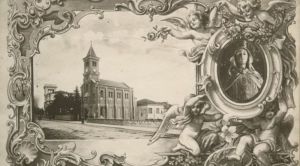 The history of the church is linked to the events of the Matuzian Parodi family, whose exponent Giovanni, known as Jan, had emigrated to Ecuador with his wife Luigia Goeta in search of fortune, then settled in 1888 in the South American country, where the Sanremo couple set up a business. When they were in the city of Guayaquil, during a sultry tropical winter of 1893, Giovanni Parodi was struck by a violent attack of yellow fever that reduced him to dying, so much so that the doctors who rushed to his bedside did not hide their deep concern about the desperate condition of the patient, to whom the doctors themselves gave no more than a day to live.
The history of the church is linked to the events of the Matuzian Parodi family, whose exponent Giovanni, known as Jan, had emigrated to Ecuador with his wife Luigia Goeta in search of fortune, then settled in 1888 in the South American country, where the Sanremo couple set up a business. When they were in the city of Guayaquil, during a sultry tropical winter of 1893, Giovanni Parodi was struck by a violent attack of yellow fever that reduced him to dying, so much so that the doctors who rushed to his bedside did not hide their deep concern about the desperate condition of the patient, to whom the doctors themselves gave no more than a day to live.
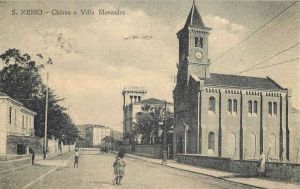 Deeply dismayed and distraught, Mrs Parodi, who was an extremely pious and devout woman, decided to visit the nearby cathedral of Our Lady of Mercy, a Madonna much venerated in the countries of Iberian culture and to whom it is customary to attribute the power to protect slaves and prisoners in general; turning to the Virgin Mary of Mercy, Luigia Goeta implored the grace for her husband, making a solemn vow that, on her return to her homeland, she and her consort would promote the erection of a church dedicated to Our Lady of Mercy in their original ward, which was that of San Martino in Sanremo. On the night following Mrs. Goeta's heartfelt prayer, Giovanni Parodi miraculously felt much better, so much so that when, the next morning, the doctor arrived at his home to observe the patient's predictable death, he found Giovanni perfectly recovered and in excellent health.
Deeply dismayed and distraught, Mrs Parodi, who was an extremely pious and devout woman, decided to visit the nearby cathedral of Our Lady of Mercy, a Madonna much venerated in the countries of Iberian culture and to whom it is customary to attribute the power to protect slaves and prisoners in general; turning to the Virgin Mary of Mercy, Luigia Goeta implored the grace for her husband, making a solemn vow that, on her return to her homeland, she and her consort would promote the erection of a church dedicated to Our Lady of Mercy in their original ward, which was that of San Martino in Sanremo. On the night following Mrs. Goeta's heartfelt prayer, Giovanni Parodi miraculously felt much better, so much so that when, the next morning, the doctor arrived at his home to observe the patient's predictable death, he found Giovanni perfectly recovered and in excellent health.
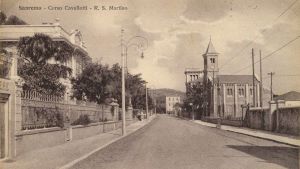
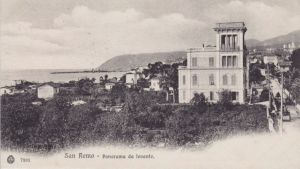 Returning to Italy around 1900, the Parodi couple decided to fulfil their vow to Our Lady of Mercy in Ecuador and in 1902 they commissioned the engineer Giulio Franco Gilli from Nice, who had already built the Villa Mercede for Parodi, to build a church, with one nave, in the western part of the garden of the villa itself, bordering the Rio San Martino. Completed in 1903, the sacred building was solemnly inaugurated and consecrated by the Bishop of Ventimiglia Daffra in the same year. Officiated in the early years as a simple chapel, it was entrusted to the care of the fathers of the Opera della Divina Provvidenza of Don Luigi Orione, who celebrated a morning mass on weekdays and the sacred services on Sundays. Later the church, in order to guarantee the population of the neighbourhood a more widespread religious service, was given in the 1920s to the Franciscan Friars Minor, to whose Provincial Curia of Genoa it was donated with a regular deed by the Parodi couple in 1935, thus remaining entrusted to their spiritual care until the present day.
Returning to Italy around 1900, the Parodi couple decided to fulfil their vow to Our Lady of Mercy in Ecuador and in 1902 they commissioned the engineer Giulio Franco Gilli from Nice, who had already built the Villa Mercede for Parodi, to build a church, with one nave, in the western part of the garden of the villa itself, bordering the Rio San Martino. Completed in 1903, the sacred building was solemnly inaugurated and consecrated by the Bishop of Ventimiglia Daffra in the same year. Officiated in the early years as a simple chapel, it was entrusted to the care of the fathers of the Opera della Divina Provvidenza of Don Luigi Orione, who celebrated a morning mass on weekdays and the sacred services on Sundays. Later the church, in order to guarantee the population of the neighbourhood a more widespread religious service, was given in the 1920s to the Franciscan Friars Minor, to whose Provincial Curia of Genoa it was donated with a regular deed by the Parodi couple in 1935, thus remaining entrusted to their spiritual care until the present day.
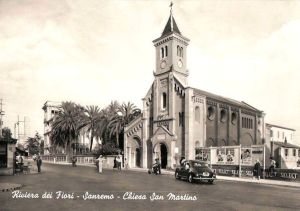
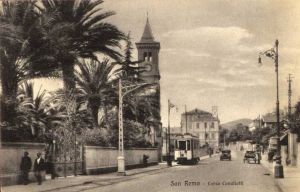 In 1937, due to the demographic increase of the district that had made the capacity of the old church insufficient. In the 1930's the church with the tram was added to the only central nave on the left side of the building, designed by architect Silvio Gabrielli.
In 1937, due to the demographic increase of the district that had made the capacity of the old church insufficient. In the 1930's the church with the tram was added to the only central nave on the left side of the building, designed by architect Silvio Gabrielli.
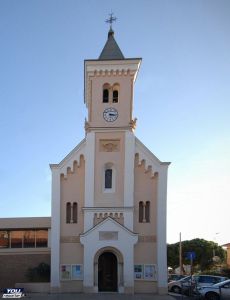
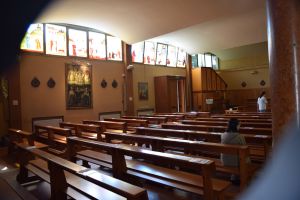 In 1977 the project of Eng. Barabino was approved, which provided for the demolition of the old nave and the construction of a new one and equipped the convent with parish works, with the aim of further enlarging the building and making it more suitable to the needs of the increased number of the faithful. The work was completed in 1984.
In 1977 the project of Eng. Barabino was approved, which provided for the demolition of the old nave and the construction of a new one and equipped the convent with parish works, with the aim of further enlarging the building and making it more suitable to the needs of the increased number of the faithful. The work was completed in 1984.
On 31 October 1938, the Bishop of Ventimiglia Rousset had in the meantime erected the Church of Mercy as a parish church, entrusted by the same prelate to the Franciscan Friars Minor, owners of the church, to which the baptismal font and the parish benefit from the Church of St. Stephen held until then by the Jesuit Fathers was transferred, with the authorisation of the Consistory Congregation, in such a way as to alleviate the discomfort of the many faithful who had encountered considerable difficulty in reaching their respective parishes to fulfil their religious practices, and in particular those of the San Martino district and the Peiranze hill towards the church of Santa Maria degli Angeli.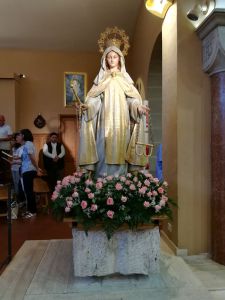 We remember the parish priests who carried out their evangelising mission: Father Camillo Romano from 1938 to 1954; Father Anselmo Perrone from 1954 to 1967; Father Guglielmo Bruschi from 1967 to 1973; Father Ludovico Brengio from 1973.
We remember the parish priests who carried out their evangelising mission: Father Camillo Romano from 1938 to 1954; Father Anselmo Perrone from 1954 to 1967; Father Guglielmo Bruschi from 1967 to 1973; Father Ludovico Brengio from 1973.
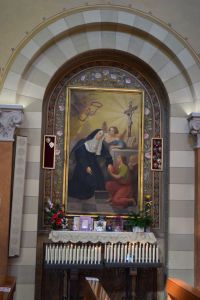 Inside there is the painting Estasi di santa Rita da Cascia, painted by G. Rolando in 1941 in the first niche on the right as you enter.
Inside there is the painting Estasi di santa Rita da Cascia, painted by G. Rolando in 1941 in the first niche on the right as you enter.
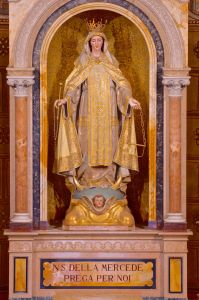
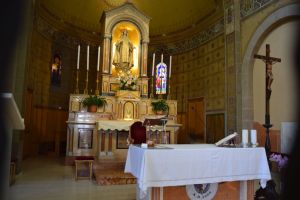 Placed above the altar of the nave is a pretty plaster statue of Our Lady of Mercy, made by a group of Spanish artists from Barcelona.
Placed above the altar of the nave is a pretty plaster statue of Our Lady of Mercy, made by a group of Spanish artists from Barcelona.
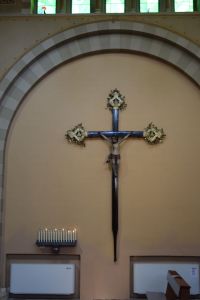 A large wooden Crucifix, placed on the right wall of the nave before the altar.
A large wooden Crucifix, placed on the right wall of the nave before the altar.
The vault of the roof is remarkable.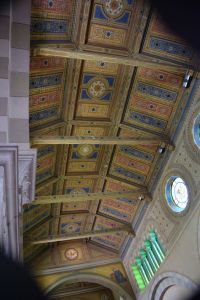
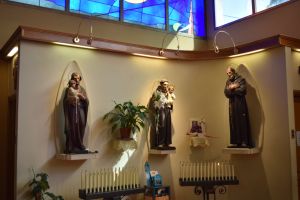 A wooden statue of St. Francis of Assisi, made by Luigi Santifaller from Ortisei and two wooden statues representing St. Joseph and St. Anthony of Padua respectively, and fourteen characteristic little paintings of the Way of the Cross.
A wooden statue of St. Francis of Assisi, made by Luigi Santifaller from Ortisei and two wooden statues representing St. Joseph and St. Anthony of Padua respectively, and fourteen characteristic little paintings of the Way of the Cross.
(sources: text elaboration by A. Gandolfo; images: our archive and Web)




